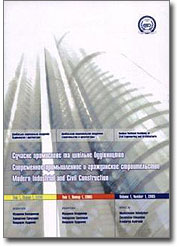Method for Quality Control of Steel Fiber Concrete by the Stress Intensity Coefficient at Normal Separation
Abstract: There are no particular obstacles for crack propagation in high-strength concrete. However, in dispersed-reinforced concrete, obstacles in the form of fibers make it difficult for the crack to spread. It is clear that under the action of the load, the development of a crack is inevitable, but additional energy is expended on overcoming each obstacle in the form of a fiber, so the process of cracking can gradually fade. Thus, the fibers in the concrete are crack inhibitors. Crack resistance is a local physicomechanical property of a solid that characterizes the ability to resist the propagation of cracks in it. Fiber concrete is a building material for which a distinctive feature is the improvement of crack resistance characteristics. The determination of the stress intensity factor makes it possible to correctly assess the resistance of the material during the formation and development of cracks. The stress intensity factor is one of the most important indicators of the crack resistance of a material such as fiber-reinforced concrete. For this reason, the methods and methods for determining this indicator should most fully disclose all the features of work under load and the quality of fiber-reinforced concrete. To determine the stress intensity factor in the laboratory, you can use the technique of S. N. Leonovich, O. V. Popov, K. A. Piradov. The essence of the method consists in determining the maximum loads destroying control specimens in compression and calculating the critical values of the stress intensity. For the authors, the task was to find a way to determine the stress intensity factor in already existing fiber-reinforced concrete structures. This article describes a method for determining the critical stress intensity factor of steel fiber concrete in a structure with normal separation. On the surface of the structure, a stress concentration zone is carried out, which is loaded through an anchor installed in a hole drilled in a fiber-reinforced concrete hole before the microvolume is pulled out. According to the obtained data, the critical stress intensity coefficient is determined. In addition to the breaking force, geometric measurements of the truncated cone of destruction of the steel-fiber concrete structure are made. According to the established relationship between them, the critical stress intensity coefficient KIC of steel fiber concrete is determined at normal separation.
Keywords: steel fiber concrete, critical intensity coefficient, crack resistance, fracture toughness, direct separation.
Pages: 85-92.
For citation:
For citation: Sadovskaya, Ye. A.; Leonovich, S. N.; Polonina, Ye. N. [et al.]. Method for Quality Control of Steel Fiber Concrete by the Stress Intensity Coefficient at Normal Separation. – Text : electronic. – In: <em>Modern Industrial and Civil Construction</em>. – 2021. – Vol. 17, N 2. – Р. 85-92. – URL: https://donnasa.ru/publish_house/journals/spgs/2021-2/02_sadovskaya_leonovich_polonina_budrevich.pdf (date of access: 22.12.2024). – ISSN 1993-3495.

Vol. 17, N 2 (2021)
Journal: Modern Industrial and Civil Construction
Publish house: Donbas National Academy of Civil Engineering and Architecture
Journal: Modern Industrial and Civil Construction
Publish house: Donbas National Academy of Civil Engineering and Architecture
